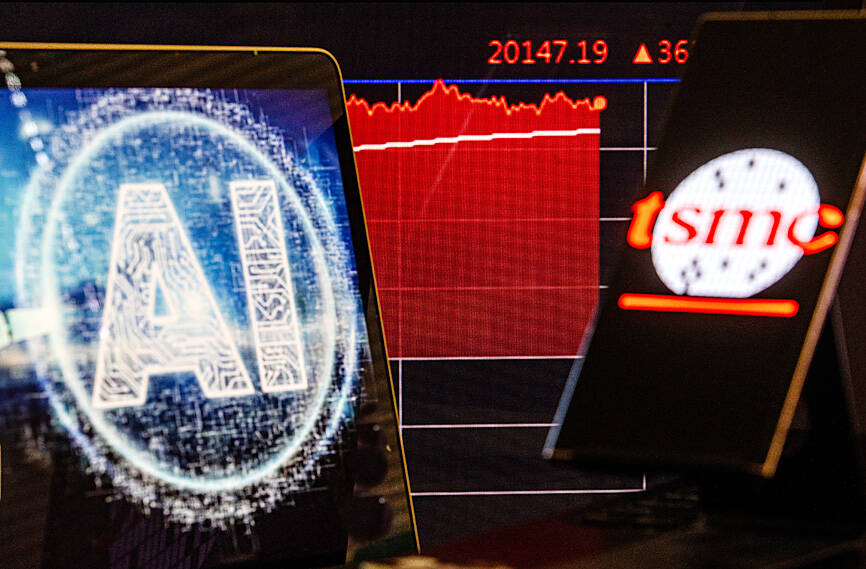The TAIEX yesterday soared more than 400 points to close above 20,000, hitting a fresh closing high as buying was sparked by rallying US markets overnight.
Gains were seen across the board with investor sentiment boosted by a dovish US Federal Reserve, which on Wednesday left its key interest rates unchanged, but hinted at three rate cuts this year.
The TAIEX closeed up 414.64 points, or 2.10 percent, at 20,199.09, with turnover totaling NT$486.001 billion (US$15.27 billion) on the main board, Taiwan Stock Exchange data showed.

Photo: CNA
The market opened flat, but momentum soon picked up as investors were motivated by the strong gains posted by the Dow Jones Industrial Average and the tech-heavy NASDAQ, both of which hit new highs overnight, dealers said.
The strength of the TAIEX continued into the end of the session on the back of a strong performance by large-cap stocks in the bellwether electronics sector and the non-technology sector, dealers added.
“The Fed implied it will lower interest rates three times this year in its updated ‘dot plot,’ which eased market concerns that the US central bank would only implement two rate cuts,” Moore Securities Investment Consulting Co (摩爾投顧) analyst Adam Lin (林漢偉) said.
A dot plot is a chart updated quarterly that records each Fed official’s projection of interest rate movements and indicates what the central bank might do next regarding monetary policy.
“It’s not just the Taipei market, other regional markets such as Tokyo and Seoul also moved sharply higher,” Lin said. “Judging from the movement in the TAIEX today, I think both foreign and local institutional investors were on the buy side. These institutional investors were more willing to take risks and take advantage of the Fed’s stance. This led to them rebuilding their positions and picking up large-cap stocks across the board, which made buying appear strong.”
Foreign institutional investors bought a net NT$18.36 billion of shares on the main board yesterday, with local investment trust firms registering a net buy of NT$11.17 billion.
The electronics index and semiconductor subindex rose 2.47 percent and 2.85 percent respectively, led by contract chipmaker Taiwan Semiconductor Manufacturing Co (TSMC, 台積電), the most heavily weighted stock on the local market.
TSMC rose 3.43 percent to close at NT$784 and the stock’s gains contributed about 210 points to the TAIEX’s rise yesterday.
Among other semiconductor stocks, DRAM chip supplier Nanya Technology Corp (南亞科技) soared 10 percent and rival Winbond Electronics Corp (華邦電子) also surged 6.33 percent after US-based Micron Technology Inc reported better-than-expected results for its fiscal second quarter.
Lin said buying spread to other technology heavyweights outside the semiconductor industry, including iPhone assembler Hon Hai Precision Industry Co (鴻海精密), second to TSMC in terms of market value, which rose 3.26 percent to close at NT$142.5 on the back of high hopes about its artificial intelligence development.
“Large-cap old economy and financial stocks also trended much higher today. These non-tech stocks had lagged behind their electronics counterparts for some time and such gains suggest a technically healthy TAIEX, but investors should keep alert over the March inflation data in the US as raw material prices have moved higher, which could affect the US markets and in turn impact shares in other markets, including in Taiwan,” Lin said.

SEEKING CLARITY: Washington should not adopt measures that create uncertainties for ‘existing semiconductor investments,’ TSMC said referring to its US$165 billion in the US Taiwan Semiconductor Manufacturing Co (TSMC, 台積電) told the US that any future tariffs on Taiwanese semiconductors could reduce demand for chips and derail its pledge to increase its investment in Arizona. “New import restrictions could jeopardize current US leadership in the competitive technology industry and create uncertainties for many committed semiconductor capital projects in the US, including TSMC Arizona’s significant investment plan in Phoenix,” the chipmaker wrote in a letter to the US Department of Commerce. TSMC issued the warning in response to a solicitation for comments by the department on a possible tariff on semiconductor imports by US President Donald Trump’s

The government has launched a three-pronged strategy to attract local and international talent, aiming to position Taiwan as a new global hub following Nvidia Corp’s announcement that it has chosen Taipei as the site of its Taiwan headquarters. Nvidia cofounder and CEO Jensen Huang (黃仁勳) on Monday last week announced during his keynote speech at the Computex trade show in Taipei that the Nvidia Constellation, the company’s planned Taiwan headquarters, would be located in the Beitou-Shilin Technology Park (北投士林科技園區) in Taipei. Huang’s decision to establish a base in Taiwan is “primarily due to Taiwan’s talent pool and its strength in the semiconductor

Industrial production expanded 22.31 percent annually last month to 107.51, as increases in demand for high-performance computing (HPC) and artificial intelligence (AI) applications drove demand for locally-made chips and components. The manufacturing production index climbed 23.68 percent year-on-year to 108.37, marking the 14th consecutive month of increase, the Ministry of Economic Affairs said. In the first four months of this year, industrial and manufacturing production indices expanded 14.31 percent and 15.22 percent year-on-year, ministry data showed. The growth momentum is to extend into this month, with the manufacturing production index expected to rise between 11 percent and 15.1 percent annually, Department of Statistics

An earnings report from semiconductor giant and artificial intelligence (AI) bellwether Nvidia Corp takes center stage for Wall Street this week, as stocks hit a speed bump of worries over US federal deficits driving up Treasury yields. US equities pulled back last week after a torrid rally, as investors turned their attention to tax and spending legislation poised to swell the US government’s US$36 trillion in debt. Long-dated US Treasury yields rose amid the fiscal worries, with the 30-year yield topping 5 percent and hitting its highest level since late 2023. Stocks were dealt another blow on Friday when US President Donald